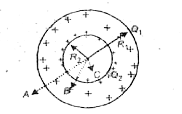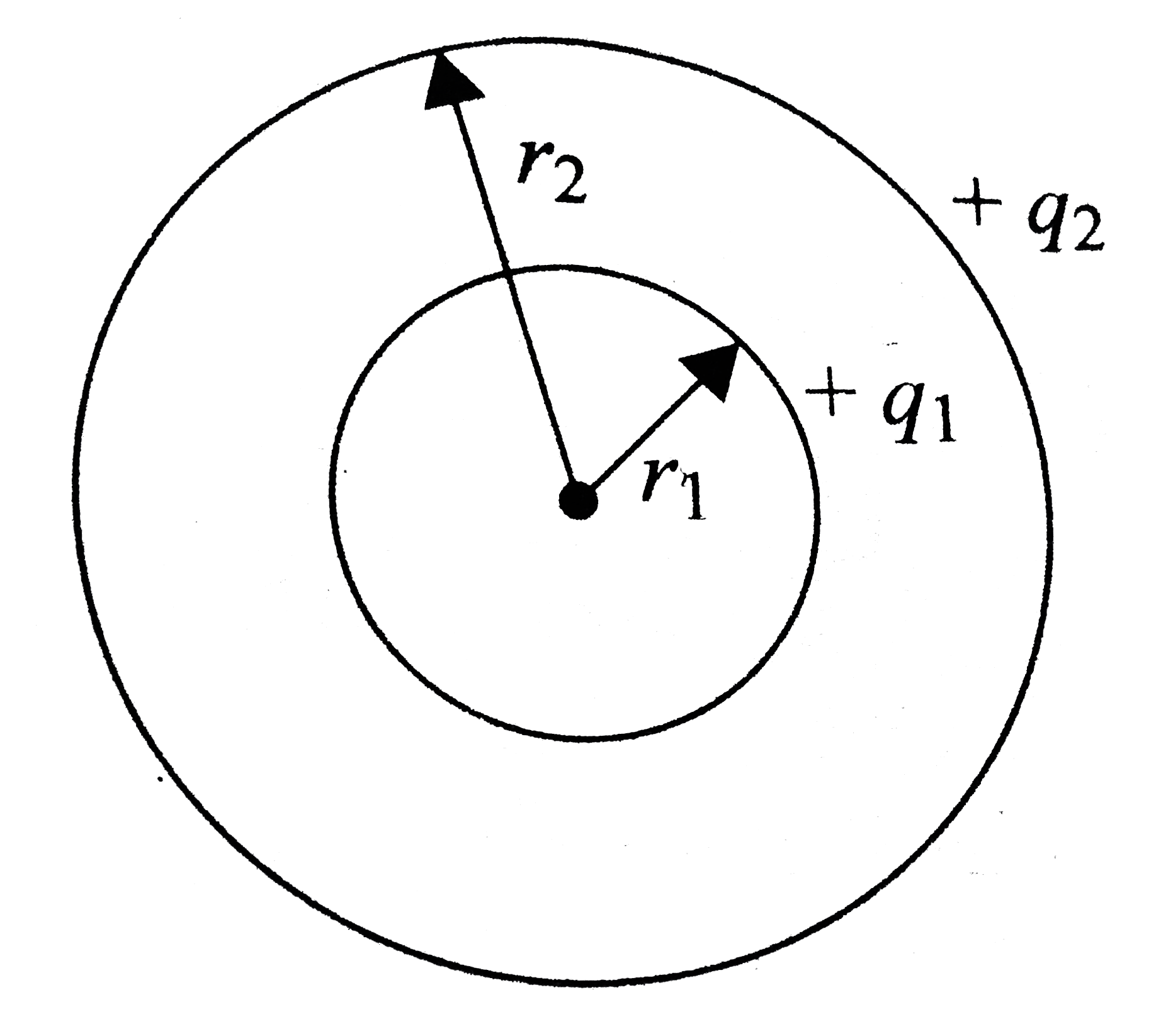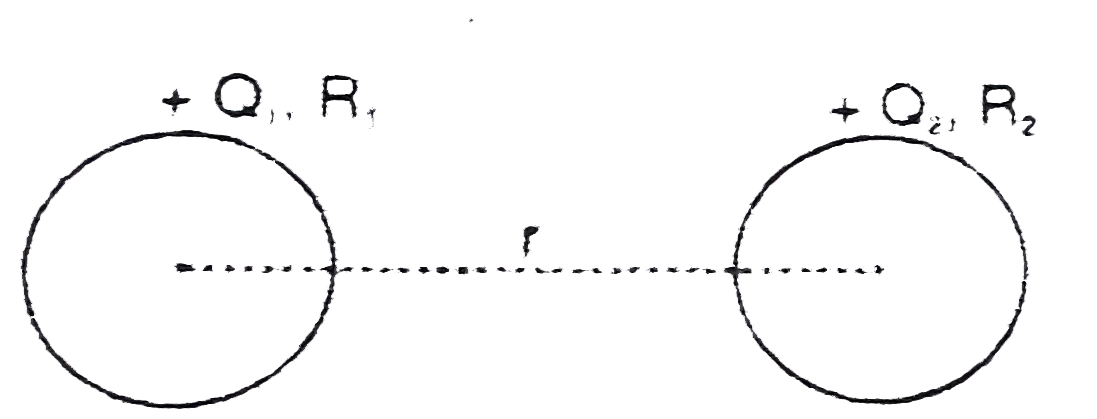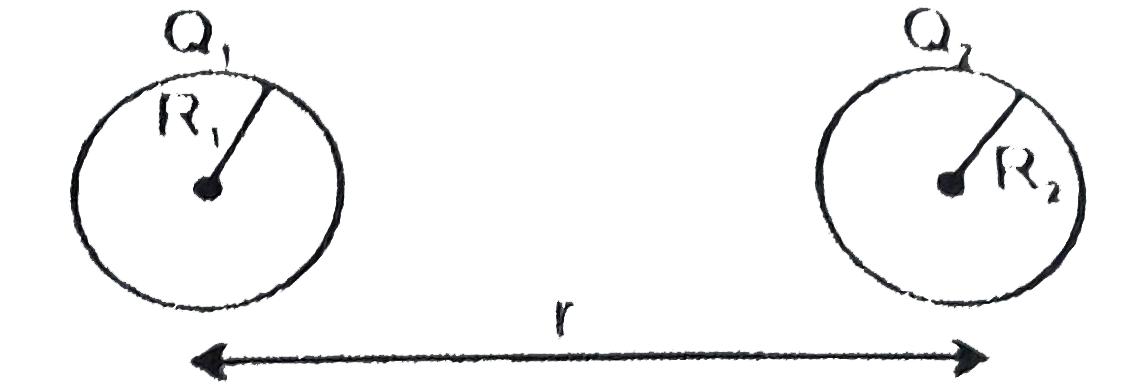You are given two concentric charged conducting spheres of radii R1andR2 such that R1>R2, having charges Q1andQ2 respectively and uniformly distributed over its surface. Calculate E and V at three points A, B , C whose distances from the centre are rA,rBandrc respectively as shown in figure.

At point A , the point A is outside both the spheres so for the purpose of calculation of E and V we have to consider both Q1andQ2 to be concentrated at the centre.
So, E (Q1+Q2)4πε0.r2AandV=(Q1+Q2)4πε0.rA
At point B : For electric field calculation note that the point B is inside the outer sphere so there will be no contribution of Q1 in the electric field at B. But for Q2 charges, the point B is outside so we have t assume Q2 to be at the centre and distance of B will be taken to be rB
So, eatB=Q24πε0r2B
Now, for potential, remember that a single charge will never give zero contribution to potential at finite pionts.
So Q1 as well as Q2 will contribute to potential at B. Noe talk about the contribution of Q1 at point B you can see that the point B is inside the large sphere of Q1so Q1 will offer its surface potential Q14πε0R1 at all its inside points. but what about the potential contribution of Q2 at point B! for Q2 the point B is outside the sphere so, we'll assume as if Q2 is concentrated at the centre and the distance taken will be rB. so the contribution of Q2 in potential will be Q24πε0rB
Hence the total potential at B = Q14πε0R1+Q24πε0rB
At point C :
For electric field note that to both Q1andQ2 . the point c is inside. So, the net contribution in the electric field will be zero, i.e E at C = zero. infact, at all the point inside the smaller sphere, the electric field will be zero,
whate about potential at C! For both the spheres the point C is inside so both Q1andQ2 will offer
their respective surface potential. since surface potential of Q1 is Q14πε0R1 and that of Q2 is Q24πε0R2 , hence the potential at C will be Q14πε0R1+Q24πε0R2
In fact at all the points inside the inner sphere the potential will be constant and will be equal to the potential at C.
Topper's Solved these Questions
- BOOK - AAKASH INSTITUTE ENGLISHCHAPTER - ELECTROSTATIC POTENTIAL AND CAPACITANCE EXERCISE - EXERCISE20videos
ELECTROSTATIC POTENTIAL AND CAPACITANCE
- BOOK - AAKASH INSTITUTE ENGLISHCHAPTER - ELECTROSTATIC POTENTIAL AND CAPACITANCE EXERCISE - ASSIGNMENT SECTION - A44videos
ELECTROSTATIC POTENTIAL AND CAPACITANCE
- BOOK - AAKASH INSTITUTE ENGLISHCHAPTER - ELECTROSTATIC POTENTIAL AND CAPACITANCE EXERCISE - SECTION-J Aakash Challengers Questions5videos
ELECTROSTATIC POTENTIAL AND CAPACITANCE
- BOOK - AAKASH INSTITUTE ENGLISHCHAPTER - ELECTROMAGNETIC WAVESEXERCISE - ASSIGNMENT SECTION - D Assertion-Reason Type Questions25videos
ELECTROMAGNETIC WAVES
- BOOK - AAKASH INSTITUTE ENGLISHCHAPTER - GRAVITATION EXERCISE - ASSIGNMENT SECTION - D (ASSERTION-REASON TYPE QUESTIONS)15videos
GRAVITATION
Similar Questions
The insulated spheres of radii R1 and R2 having charges Q1 and Q2 respectively are connected to each other. There is
View SolutionThe insulated spheres of radii R1 and R2 having charges Q1 and Q2 respectively are connected to each other. There is
View SolutionThe capacitance of two concentric spherical shells of radii R1 and R2(R2>R1) is
View SolutionTwo concentric spherical shells of radius R1 and R2(R2>R1) are having uniformly distributed charges Q1 and Q2 respectively. Find out total energy of the system.
 View Solution
View SolutionTwo concentric, thin metallic spheres of radii R1andR2(R1>R2) charges Q1andQ2 respectively Then the potential at radius r between R1andR2 will be (k=1/4π∈)
View SolutionFigure shows two concentric conducting shells of radii r1 and r2 carrying uniformly distributed charges q1 and q2, respectively. Find an expression for the potential of each shell.
 .View Solution
.View SolutionFind force acting between two shells of radius R1 and R2 which have uniformly distributed charges Q1 and Q2 respectively and distance between their centres is r.
 View Solution
View SolutionA charge Q has been divided on two concentirc conducting spheres of radii R1andR2(R1>R2) such that the surface charge densities on both the sphere is same. Find the potential at their common center.
View SolutionTwo non-conduction hollow uniformly charged spheres of radil R1 and R2 with charge Q1 and Q2 respectively are places at a distance r. Find out total energy of the system.
 View Solution
View SolutionTwo concentric conducting shells of radii R and 2R are having charges Q and -2Q respectively.In a region r
View Solution

